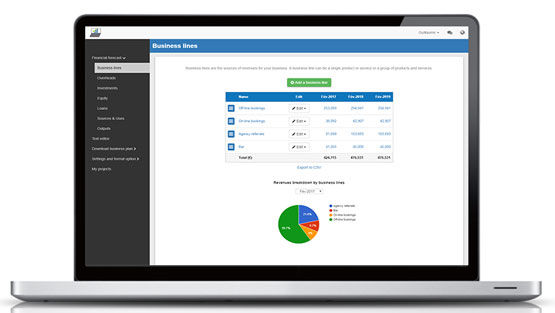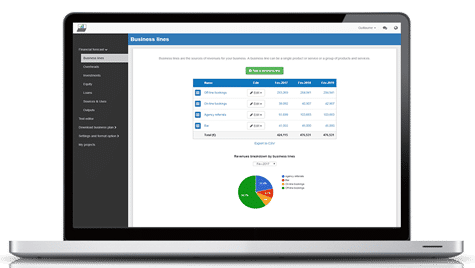How to open a fruit juice brand?
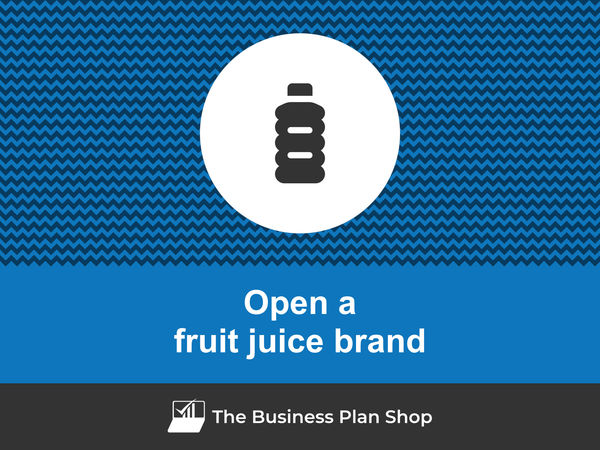
Are you keen to open a fruit juice brand but don't know where to begin? Then you're in luck because this guide will lead you through all the steps required to check if your business idea can be profitable and, if so, turn it into a reality.
Our guide is for prospective entrepreneurs who are thinking about starting a fruit juice brand no matter how far they are in their journey - whether you’re just thinking about it or in the middle of market research this guide will be useful to you.
Think of this as your blueprint: we cover everything you need to know about opening a fruit juice brand and what key decisions you’ll need to make along the way.
Ready? Let’s get started!
Understanding how a fruit juice brand works
The very first step when exploring a business idea such as starting a fruit juice brand is to make sure you understand how the business operates and makes money (which is what we call the business model).
This will not only give you an initial idea of how profitable the business can be, but it will also enable you to make sure that this is the right business idea for you, given your skills, start-up capital and family or personal lifestyle, in particular.
The best ways to get to grips with the fruit juice brand's business model are to:
- Talk to fruit juice brand owners with experience
- Work a few months in a fruit juice brand already in operation
- Take a training course
Talk to fruit juice brand owners with experience
Experienced fruit juice brand owners have valuable insights and can provide practical advice based on their firsthand experiences.
They've likely encountered and overcome challenges that a newcomer might not anticipate. Learning from other’s mistakes can save you both time and money and potentially increase your venture’s chances of succeeding.
Work a few months in a fruit juice brand already in operation
Obtaining work experience in the industry can be a crucial factor in confirming whether you truly want to start a fruit juice brand, as it provides insight into the day-to-day activities.
For instance, if the working hours are longer than expected or if other business requirements don't align with your personal lifestyle or preferences, you might reconsider your entrepreneurial goals.
Even if you've decided that this business idea is a good fit for you, gaining work experience will still be valuable. It helps you better understand your target market and customer needs, which is likely to be beneficial when launching your own fruit juice brand.
Take a training course
Obtaining training within your chosen industry is another way to get a feel for how a fruit juice brand works before deciding to pursue a new venture.
Whatever approach you choose to familiarise yourself with the business, before going any further with your plans to open a fruit juice brand, make sure you understand:
- What skills are required to run the business (compare this with your own skills)
- What a typical week in the business is like (compare this with your personal or family life)
- What is the potential turnover of a fruit juice brand and the long-term growth prospects (compare this with your level of ambition)
- Your options once you decide to sell the business or retire (it's never too early to consider your exit)
Assemble your fruit juice brand's founding team
The next step to start your fruit juice brand is to think about the ideal founding team, or to go in alone (which is always an option).
Setting up a business with several partners is a way of reducing the (high) risk of launching a fruit juice brand since it allows the financial risk of the project to be shared between the co-founders.
This also allows the company to benefit from a greater diversity of profiles in the management team and to spread the burden of decision-making over several shoulders.
But, running a business with multiple co-founders brings its own challenges. Disagreements between co-founders are quite common, and these can pose risks to the business. That's why it's crucial to consider all aspects before starting your business.
To make an informed decision, we suggest asking yourself these questions:
- How many co-founders would increase the project's chances of success?
- Do you and your potential partners share the same aspirations for the project?
- What is your plan B in case of failure?
Let's examine each of these questions in detail.
How many co-founders would increase the project's chances of success?
The answer to this question will depend on a number of factors, including:
- Your savings compared with the amount of initial capital needed to launch the fruit juice brand
- The skills you have compared with those needed to make a success of such a project
- How you want key decisions to be taken in the business (an odd number of partners or a majority partner is generally recommended to avoid deadlock)
Put simply, your partners contribute money and/or skills, and increasing the number of partners is often a good idea when one of these resources is in short supply.
Do you and your potential partners share the same aspirations for the project?
One of the key questions when selecting your potential partners will be their expectations. Do you want to create a small or large business? What are your ambitions for the next 10 or 15 years?
It's better to agree from the outset on what you want to create to avoid disagreements, and to check that you stay on the same wavelength as the project progresses to avoid frustration.
What is your plan B in case of failure?
Of course, we wish you every success, but it's wise to have a plan B when setting up a business.
How you handle the possibility of things not working out can depend a lot on the kind of relationship you have with your co-founders (like being a close friend, spouse, former colleague, etc.) and each person's individual situation.
Take, for instance, launching a business with your spouse. It may seem like a great plan, but if the business doesn't succeed, you could find yourself losing the entire household income at once, and that could be quite a nerve-wracking situation.
Similarly, starting a business partnership with a friend has its challenges. If the business doesn't work out or if tough decisions need to be made, it could strain the friendship.
It's essential to carefully evaluate your options before starting up to ensure you're well-prepared for any potential outcomes.
Is there room for another fruit juice brand on the market?
The next step in starting a fruit juice brand is to undertake market research. Now, let's delve into what this entails.
The objectives of market research
The goal here is straightforward: evaluate the demand for your business and determine if there's an opportunity to be seized.
One of the key points of your market analysis will be to ensure that the market is not saturated by competing offers.
The market research to open your fruit juice brand will also help you to define a concept and market positioning likely to appeal to your target clientele.
Finally, your analysis will provide you with the data you need to assess the revenue potential of your future business.
Let's take a look at how to carry out your market research.
Evaluating key trends in the sector
Market research for a fruit juice brand usually begins with an analysis of the sector in order to develop a solid understanding of its key players, and recent trends.
Assessing the demand
After the sector analysis comes demand analysis. Demand for a fruit juice brand refers to customers likely to consume the products and services offered by your company or its competitors.
Looking at the demand will enable you to gain insights into the desires and needs expressed by your future customers and their observed purchasing habits.
To be relevant, your demand analysis must be targeted to the geographic area(s) served by your company.
Your demand analysis should highlight the following points:
- Who buys the type of products and services you sell?
- How many potential customers are there in the geographical area(s) targeted by your company?
- What are their needs and expectations?
- What are their purchasing habits?
- How much do they spend on average?
- What are the main customer segments and their characteristics?
- How to communicate and promote the company's offer to reach each segment?
Analyzing demand helps pinpoint customer segments your fruit juice brand could target and determines the products or services that will meet their expectations.
Assessing the supply
Once you have a clear vision of who your potential customers are and what they want, the next step is to look at your competitors.
Amongst other things, you’ll need to ask yourself:
- What brands are competing directly/indirectly against your fruit juice brand?
- How many competitors are there in the market?
- Where are they located in relation to your company's location?
- What will be the balance of power between you and your competitors?
- What types of services and products do they offer? At what price?
- Are they targeting the same customers as you?
- How do they promote themselves?
- Which concepts seem to appeal most to customers?
- Which competitors seem to be doing best?
The aim of your competitive analysis will be to identify who is likely to overshadow you, and to find a way to differentiate yourself (more on this see below).
Regulations
Market research is also an opportunity to look at the regulations and conditions required to do business.
Ask yourself the following questions:
- Do you need a special degree to open a fruit juice brand?
- Are there necessary licences or permits?
- What are the main laws applicable to your future business?
At this stage, your analysis of the regulations should be carried out at a high level, to familiarize yourself with any rules and procedures, and above all to ensure that you meet the necessary conditions for carrying out the activity before going any further.
You will have the opportunity to come back to the regulation afterwards with your lawyer when your project is at a more advanced stage.
Take stock of the lessons learned from your market analysis
Market research should give you a definitive idea of your business idea's chances of commercial success.
Ideally, the conclusion is that there is a market opportunity because one or more customer segments are currently underserved by the competition.
On the other hand, the conclusion may be that the market is already taken. In this case, don't panic: the first piece of good news is that you're not going to spend several years working hard on a project that has no chance of succeeding. The second is that there's no shortage of ideas out there: at The Business Plan Shop, we've identified over 1,300 business start-up ideas, so you're bound to find something that will work.
Choose the right concept and position your fruit juice brand on the market
The next step to start a fruit juice brand is to choose the company's market positioning.
Market positioning refers to the place your product and service offering occupies in customers' minds and how it differs from how competitors are perceived. Being perceived as a high-end solution, for example.
To do this, you need to take the following considerations into account:
- How can you make your business stand out from your competitors?
- Is it better to start a new fruit juice brand or acquire one that is already up and running?
- How to make sure your concept meets customer needs?
Let's look at each of these in a little more detail.
How can you make your business stand out from your competitors?
When you decide to start your own fruit juice brand, you're facing an upward challenge because your competitors are already ahead. They have a good reputation, loyal customers, and a strong team, while you're just getting started.
Opening a fruit juice brand offering exactly the same thing as your competitors is risky and potentially doomed to fail: why would customers take the risk of choosing a newcomer rather than a company with a proven track record?
This is why it is advisable to avoid direct confrontation by adopting a differentiated market positioning wherever possible: in other words, by offering something different or complementary to what is available on the market.
To find a market positioning that has every chance of success, you need to ask yourself the following questions:
- Can you negate direct competition by serving a customer profile that is currently poorly addressed by your competitors?
- Can your business provide something different or complementary to what is already available on the market?
- Why will customers choose your fruit juice brand over the competition?
- How will your competitors react to your entry into their market?
- Is the market sufficiently large to allow you to set up a new independent business, or is it better to consider another avenue (see below)?
Is it better to start a new fruit juice brand or acquire one that is already up and running?
A way to benefit from a proven concept and reduce the risk of your project is to take over a fruit juice brand.
Buying a fruit juice brand allows you to get a team, a customer base, and above all to preserve the balance on the market by avoiding creating a new player. For these reasons, taking over a business is a lot less risky than creating one from scratch.
Taking over a business also gives you greater freedom than franchising, because you have the freedom to change the positioning and operations of the business as you see fit.
However, as you can imagine, the cost of taking over a business is higher than that of opening a fruit juice brand because you will have to finance the purchase.
How to make sure your concept meets customer needs?
Once you have decided on your concept and the market positioning of your future fruit juice brand, you will need to check that it meets the needs, expectations and desires of your future customers.
To do this, you need to present it to some of your target customers to gather their impressions.
Deciding where to base your fruit juice brand
The next step to opening a fruit juice brand is deciding where you want to set up your business.
Choosing the right location for your business is like finding the perfect stage for a play. Without it, your business may lack the spotlight it deserves.
Whilst there is no “perfect” location for your fruit juice brand, one that meets as many of the following factors as possible could be ideal:
This list is obviously not exhaustive and will have to be adapted to the particularities of your project.
Once you’ve considered the factors above, it’s important to think about the budget that your startup has at its disposal. You’ll need to find a location that meets your business requirements but is affordable enough, especially short-term.
If you opt for renting instead of buying your premises, make sure to take into account the terms of the lease, including aspects such as the duration, rent increase, renewal, and so on.
The lease contractual terms vary greatly from country to country, so be sure to check the terms applicable to your situation and have your lease reviewed by your lawyer before signing.
What legal form should I choose for my fruit juice brand?
The next step to start a fruit juice brand is to choose the legal form of your business.
The legal form of a business simply means the legal structure it operates under. This structure outlines how the business is set up and defines its legal obligations and responsibilities.
Why is your fruit juice brand's legal form important?
Choosing the right legal form for your fruit juice brand is important because this will affect:
- Taxation: your tax obligations depend on the legal structure you choose, and this principle applies to both personal income tax and business taxes.
- Risk exposure: some legal structures have a legal personality (also known as corporate personality) and limited liability, which separates them from the owners running the business. This means that the business would be liable rather than the owners if things were to go wrong (lawsuit, debt owed in case of bankruptcy, etc.).
- Decision-making and governance: how you make key decisions varies based on the legal form of your business. In some cases you might need to have a board of directors and organise general assemblies to enable shareholders to influence major decisions with their voting rights.
- Financing: securing funding from investors requires you to have a company and they will expect limited liability and corporate personality to protect them legally.
- Paperwork and legal formalities: the legal structure you select determines whether certain obligations are necessary, such as producing annual accounts, or getting your books audited.
Popular business legal forms
The specific names of legal structures vary from country to country, but they usually fall within the two main categories below:
- Individual businesses
- Companies
Individual businesses
Individual businesses, like sole traders or sole proprietorships, are made for self-employed entrepreneurs and freelancers rather than businesses which employ staff.
They benefit from straightforward administrative requirements, minimal paperwork to start, simpler tax calculations, and streamlined accounting procedures.
However, the downside is that there's typically no legal distinction between the business and the person responsible for day-to-day operations. This means the owner's personal assets are at risk if the business faces problems or goes bankrupt.
There is also no share capital in such a structure, meaning that individual businesses cannot raise equity from investors which seriously limits funding options.
Companies
Companies are versatile structures suited to projects of all sizes in terms of number of founders, number of employees and amount of capital.
They are a bit more complex to operate than individual businesses with more formalities, stringent accounting requirements, more complex tax implications, etc.
In return, they offer stronger protections to their shareholders. They usually benefit from having their own legal identity and limited liability, meaning co-founders and investors can only ever lose the amount of money they have put into the company.
For instance, if things were to go south (the company files for bankruptcy or there is a legal issue), the company would take the hit, safeguarding the personal assets of the founders and investors.
How should I choose my fruit juice brand's legal structure?
Deciding on a legal form is easy once you've estimated your sales, decided whether or not you need employees and figured out the number of co-founders joining you.
It's essential to remember that a solid business idea will succeed no matter which legal structure you pick. Tax laws change regularly, so you can't rely on specific tax advantages tied to a particular structure when starting a business.
A proven approach is to look at what legal structures your top competitors are using, and go with the most common option as a working assumption. Once your idea is mature enough, and you're getting closer to officially registering your business, you can get advice from a lawyer and an accountant to confirm your choice.
Can I switch my fruit juice brand's legal structure if I get it wrong?
Yes, changing your legal structure later is possible, though it may involve selling the old entity to a new entity in some cases, which adds further expenses. If you want to save on such costs, it makes sense to pick the correct legal form for your business the first time around.
Calculating the budget to open a fruit juice brand
The next step to opening a fruit juice brand involves thinking about the equipment and staff needed to launch and run your business on a day-to-day basis.
Each project has its own characteristics, which means that it is not possible to estimate the budget for opening a fruit juice brand without building a complete financial forecast.
So be careful when you see estimates circulating on the Internet. As with all figures, ask yourself these questions:
- Is my project similar (location, concept, size, etc.)?
- How recent is the information?
- Is it from a trustworthy source?
Startup costs and investments to open a fruit juice brand
For a fruit juice brand, the initial working capital requirements and investments may include the following elements:
- Production equipment: This includes items such as juicers, blenders, and packaging machines that are necessary for producing your fruit juice. These are considered fixed assets because they are not meant to be consumed or sold within a year.
- Storage facilities: As your fruit juice brand grows, you will need to invest in storage facilities to store your raw materials, finished products, and packaging materials. This could include refrigerated warehouses or storage tanks for fresh fruit juice.
- Delivery vehicles: You will need reliable transportation to deliver your fruit juice to retailers and distributors. This could include refrigerated trucks or vans to ensure the quality and freshness of your product during transportation.
- Bottling and labeling equipment: In addition to production equipment, you will also need equipment for bottling and labeling your fruit juice. This could include bottling machines, labeling machines, and other equipment specific to your packaging needs.
- Furniture and fixtures: This includes items such as shelves, tables, and chairs for your retail store or tasting room. These are considered fixed assets because they are necessary for the operation of your business and are not meant to be consumed or sold within a year.
Of course, you will need to adapt this list to your company's specific needs.
Staffing plan to operate a fruit juice brand
To establish an accurate financial forecast for your fruit juice brand, you will also need to assess your staffing requirements.
The extent to which you need to recruit will of course depend on your ambitions for the company's growth, but you might consider recruiting for the following positions:
Once again, this list is only indicative and will need to be adjusted according to the specifics of your fruit juice brand.
Other operating expenses required to run a fruit juice brand
You also need to consider operating expenses to run the business:
- Staff costs: This includes salaries, benefits, and training for all employees working in roles such as production, sales, marketing, and administration.
- Raw materials: This includes the cost of purchasing fruits, packaging materials, and other ingredients needed to make the fruit juice.
- Utilities: This includes electricity, water, and gas expenses for operating the production facilities and office space.
- Rent: This includes the cost of leasing or renting production facilities, warehouse space, and office space.
- Marketing and advertising: This includes expenses for promoting the fruit juice brand through advertisements, social media, events, and influencer partnerships.
- Distribution costs: This includes the cost of transportation, storage, and delivery of the fruit juice to retailers and distributors.
- Packaging costs: This includes the cost of designing and producing packaging materials for the fruit juice.
- Accountancy fees: This includes the cost of hiring an accountant or accounting firm to handle financial statements, tax filings, and other financial matters.
- Insurance costs: This includes the cost of insuring the production facilities, equipment, and employees.
- Software licenses: This includes the cost of purchasing and renewing software licenses for programs used in operations, such as inventory management and accounting software.
- Banking fees: This includes fees for bank accounts, credit card processing, and other financial transactions.
- Research and development: This includes expenses for developing new fruit juice flavors, improving existing recipes, and conducting market research.
- Consulting fees: This includes the cost of hiring consultants for business strategy, marketing, and other specialized services.
- Licenses and permits: This includes fees for obtaining necessary licenses and permits for operating a food and beverage business.
- Travel and entertainment: This includes expenses for business travel, client meetings, and team building events.
This list will need to be adapted to the specifics of your fruit juice brand but should be a good starting point for your budget.
Create a sales & marketing plan for your fruit juice brand
The next step to launching your fruit juice brand is to think about the actions you need to take to promote your products and services and build customer loyalty.
Here, you'll be looking at the following issues:
- What is the best method to attract as many new customers as possible?
- How to build customer loyalty and spread word of mouth?
- What human and financial resources will be required to implement the planned actions?
- What level of sales can I expect to generate in return?
The precise sales and marketing levers to activate will depend on the size of your fruit juice brand. But you could potentially leverage some of the initiatives below.
Besides your sales and marketing plan, your sales forecast will be affected by seasonal patterns related to the nature of your business, such as fluctuations during the holiday season, and your competitive landscape.
Building your fruit juice brand's financial forecast
The next step to opening a fruit juice brand is to create your financial forecast.
What is a fruit juice brand financial forecast?
A fruit juice brand financial forecast is a forward-looking tool that projects the financial performance of your business over a specific period (usually 3 years for start-ups).
A forecast looks at your business finances in detail - from income to operating costs and investments - to evaluate its expected profitability and future cash flows.
Building a financial forecast enables you to determine the precise amount of initial financing required to start your fruit juice brand.
There are many promising business ideas but very few are actually viable and making a financial forecast is the only way to ensure that your project holds up economically and financially.

Your financial forecast will also be part of your overall business plan (which we will detail in a later step), which is the document you will need to secure financing.
Financial forecasts are used to drive your fruit juice brand and make key decisions, both in the pre and post-launch phases:
- Should we go ahead with the business or scrap the idea?
- Should we hire staff or use an external service provider?
- Which development project offers the best growth prospects?
- Etc.
Creating a financial forecast for starting a fruit juice brand is an iterative process as you will need to refine your numbers as your business idea matures.
As your fruit juice brand grows, your forecasts will become more accurate. You will also need to test different scenarios to ensure that your business model holds true even if economic conditions deteriorate (lower sales than expected, difficulties in recruiting, sudden cost increases or equipment failure problems, for example).
Once you’ve launched your business, it will also be important to regularly compare your accounting data to your financial projections in order to keep your forecast up-to-date and maintain visibility on future cash flows.
What does a financial projection look like?
The following financial tables will be used to present your fruit juice brand's financial forecast.
The projected P&L statement
Your fruit juice brand's forecasted P&L statement will enable you to visualise your fruit juice brand's expected growth and profitability over the next three to five years.
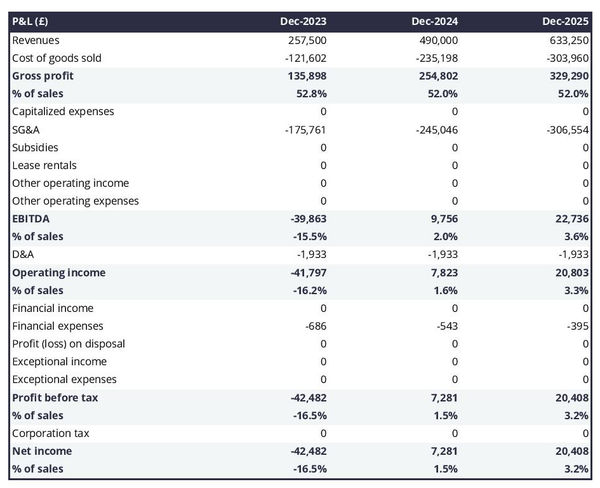
The projected balance sheet of your fruit juice brand
The projected balance sheet gives an overview of your fruit juice brand's financial structure at the end of the financial year.
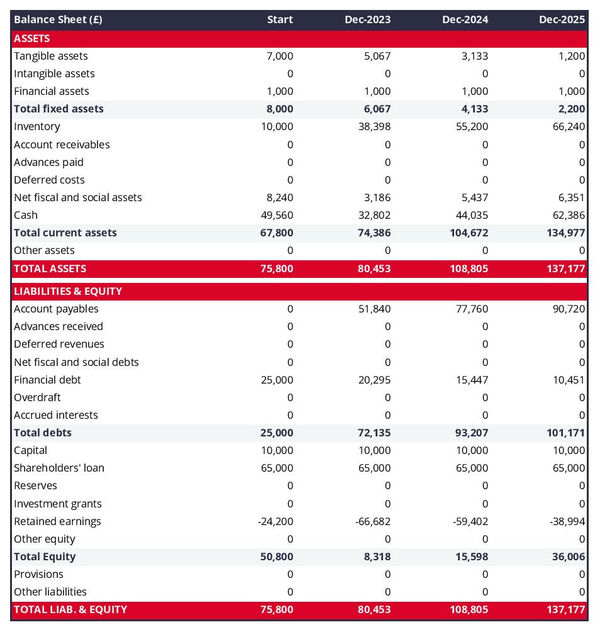
The cash flow projection
A cash flow forecast for a fruit juice brand shows the projected inflows and outflows of cash over a specific period, providing insights into liquidity and financial health.
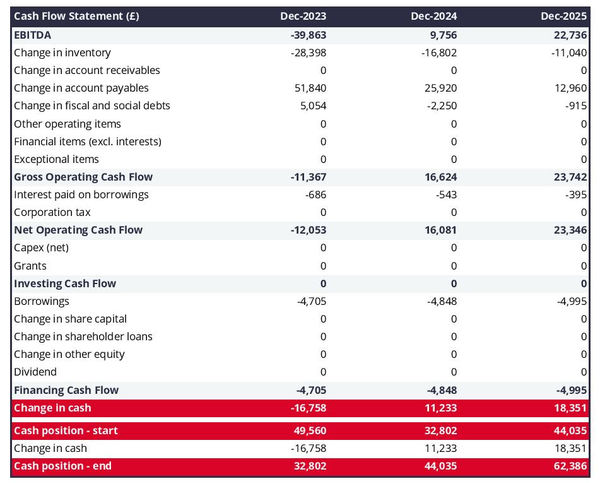
What is the best financial forecasting tool for starting your fruit juice brand?
The simplest and easiest way to create your fruit juice brand's projections is to use professional online financial forecasting software such as the one we offer at The Business Plan Shop.
There are several advantages to using specialised software:
- You can easily create your financial forecast by letting the software take care of the financial calculations for you without errors
- You have access to complete financial forecast templates
- You get a complete financial forecast ready to be sent to your bank or investors
- The software helps you identify and correct any inconsistencies in your figures
- You can create scenarios to stress-test your forecast's main assumptions to stress-test the robustness of your business model
- After you start trading, you can easily track your actual financial performance against your financial forecast, and recalibrate your forecast to maintain visibility on your future cash flows
- You have a friendly support team on standby to assist you when you are stuck
If you are interested in this type of solution, you can try our forecasting software for free by signing up here.
How do I choose a name and register my fruit juice brand?
Now that your project of launching a fruit juice brand is starting to take shape, it's time to look at the name of your business.
Finding the name itself is generally fairly easy. The difficulty lies in registering it.
To prevent this guide from being too long, we won't go into all the criteria you need to take into account when choosing a striking name for your fruit juice brand. However, try to choose a name that is short and distinctive.
Once you have a name that you like, you need to check that it is available, because you cannot use a name that is identical or similar to that of a competitor: this type of parasitic behaviour is an act of unfair competition for which you risk being taken to court by your competitors.
To avoid any problems, you will need to check the availability of the name:
- Your country's company register
- With the trademark register
- With a domain name reservation company such as GoDaddy
- On an Internet search engine
If the desired name is available, you can start the registration process.
It is common to want to use the trading name as the name of the company, and to have a domain name and a registered trademark that also correspond to this name: Example ® (trading name protected by a registered trademark), Example LTD (legal name of the company), example.com (domain name used by the company).
The problem is that each of these names has to be registered with a different entity, and each entity has its own deadlines:
- Registering a domain name is immediate
- Registering a trademark usually takes at least 3 months (if your application is accepted)
- The time taken to register a new business depends on the country, but it's generally quite fast
How do I go about it?
Well, you have two choices:
- Complete all registrations at the same time and cross your fingers for a smooth process.
- Make sure to secure the domain names and trademarks. Once that's done, wait for confirmation of a successful trademark registration before moving on to register the company.
At The Business Plan Shop, we believe it's essential to prioritize securing your domain names and trademarks over the business name. This is because you have the flexibility to use a different trading name than your legal business name if needed.
Regardless, we suggest discussing this matter with your lawyer (see below in this guide) before making any decisions.
What corporate identity do I want for my fruit juice brand?
The following step to start a fruit juice brand is to define your company's visual identity.
Visual identity is part of the DNA of your fruit juice brand: it makes you recognizable and recognized by your customers, and helps you stand out from the competition. It also helps convey your values, notably through the choice of colors that identify the company.
Creating your business's visual identity yourself is entirely possible: there are several online tools that let you generate color palettes, choose typography and even generate logos.
However, we advise you to delegate this task to a designer or a communications agency for a professional result.
Your corporate identity will include the following elements:
- Your business logo
- Your brand guidelines
- Your business cards
- Design and theme of your website
Logo
Your fruit juice brand's logo serves as a quick identifier for your company. It will be featured on all your communication platforms (website, social networks, business cards, etc.) and official documents (invoices, contracts, etc.).
Beyond its appearance, your logo should be easy to use on any type of support and background (white, black, gray, colored, etc.). Ideally, it should be easy to use in a variety of colors.
Brand guidelines
One of the challenges when starting a fruit juice brand is to ensure a consistent brand image wherever your company is visible.
This is the role of your company's brand guidelines, which defines the typography and colors used by your brand and thus acts as the protector of your brand image.
Typography refers to the fonts used (family and size). For example, Trebuchet in size 22 for your titles and Times New Roman in size 13 for your texts.
The colors chosen to represent your brand should typically be limited to five (or fewer):
- The main colour,
- A secondary colour (the accent),
- A dark background colour (blue or black),
- A grey background colour (to vary from white),
- Possibly another secondary colour.
Business cards
Classic but a must-have, your business cards will be at your side to help you easily communicate your contact details to your founders, customers, suppliers, recruitment candidates, etc.
In essence, they should feature your logo and adhere to the brand guidelines mentioned earlier.
Website theme
Likewise, the theme of your fruit juice brand website will integrate your logo and follow the brand guidelines we talked about earlier.
This will also define the look and feel of all your site's graphic elements:
- Buttons
- Menus
- Forms
- Banners
- Etc.
What legal steps are needed to start a fruit juice brand?
The next step in opening a fruit juice brand is to look in detail at the legal and regulatory formalities.
Although it is possible to do the formalities yourself and draft some of the documents detailed here, The Business Plan Shop recommends that you seek advice on these aspects from a law firm.
Registering a trademark and protecting the intellectual property of your fruit juice brand
One of the first things you need to do here is to protect your company's current and future intellectual property.
One way of doing this is to register a trade mark, as mentioned earlier in this guide. Your lawyer will be in a position to do the formalities for you and to help you select the classes (economic activities) and jurisdictions in which you have an interest in obtaining protection.
Your law firm can also advise you on other ways of protecting your company's intellectual property.
Preparing the legal documents for your fruit juice brand
Your fruit juice brand will need a set of legal and contractual documents to operate on a daily basis.
Your exact needs in this respect will depend on the country in which you are launching your fruit juice brand and the size and legal form envisaged for the company. Once again, we highly recommend having these documents prepared by your lawyer.
As a minimum, we recommend that you have the following documents prepared:
- Employment contracts
- General terms and conditions of sale
- General terms and conditions of use for your website
- Privacy Policy for your website
- Cookie Policy for your website
- Invoices
- Etc.
Applying for licences and permits and registering for various taxes
Here too, the list of licences and business permits required for your business to operate legally will depend on the country in which you have decided to start your fruit juice brand.
Your law firm will be able to advise you on all the regulations applicable to your business.
Likewise, your accountant will be able to assist you and take care of the formalities involved in complying with the tax authorities.
Create a business plan for your fruit juice brand
The next step to open a fruit juice brand: put together your business plan.
What is a business plan?
To keep it simple, a business plan comprises two crucial components:
- Firstly, a numerical part, the financial forecast (which we mentioned earlier), which highlights the initial financing requirements and profitability potential of the fruit juice brand,
- And a written, well-argued section that presents your project in detail, aims to convince the reader of its chances of success, and provides the context needed to assess whether the forecast is realistic or not.
The business plan will enable you to verify the coherence of your project, and ensure that the company can be profitable before incurring further costs. It will also help you convince business and financial partners.
As you can see, your business plan must be convincing and error-free.
How to write a business plan for a fruit juice brand?
Nowadays, the modern and most efficient way to write a fruit juice brand business plan is to use startup business plan software like the one we offer at The Business Plan Shop.
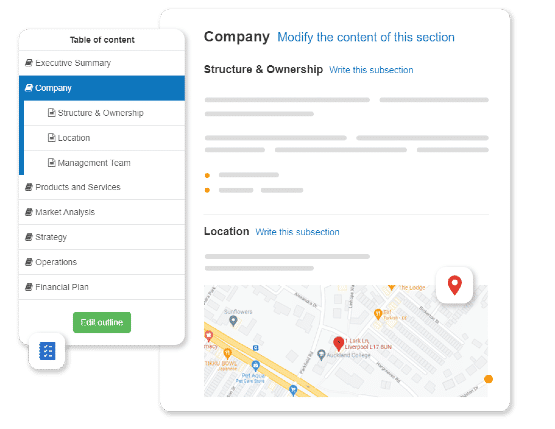
Using The Business Plan Shop to create a business plan for afruit juice brand has several advantages :
- You can easily create your financial forecast by letting the software take care of the financial calculations for you without errors
- You are guided through the writing process by detailed instructions and examples for each part of the plan
- You can access a library of dozens of complete startup business plan samples and templates for inspiration
- You get a professional business plan, formatted and ready to be sent to your bank or investors
- You can create scenarios to stress test your forecast's main assumptions
- You can easily track your actual financial performance against your financial forecast by importing accounting data
- You can easily update your forecast as time goes by to maintain visibility on future cash flows
- You have a friendly support team on standby to assist you when you are stuck
If you're interested in using this type of solution, you can try The Business Plan Shop for free by signing up here.
How to raise finance for my fruit juice brand?
Once your business plan has been drafted, you’ll need to think about how you might secure the financing necessary to open your fruit juice brand.
The amount of initial financing required will obviously depend on the size of your fruit juice brand and the country in which you wish to set up.
Businesses have access to two main categories of financing: equity and debt. Let's take a closer look at how they work and what sources are available.
Equity funding
At a high level, the equity of your fruit juice brand will consist of the money that founders and potential investors will invest to launch the company.
Equity is indispensable as it provides the company with a source of long-term (often permanent) financing and demonstrates the founders' conviction in the company's chances of success, since their investments would be lost in the event of bankruptcy.
Equity investors can generate a return on their investment through dividends (which can only be paid out if the company is profitable) or capital gains on the resale of their shares (if the company is attractive enough to attract a buyer).
As you can see, the equity investors' position is extremely risky, since their capital is at risk and can be lost in the event of bankruptcy, and the company must be profitable or resellable before they can hope to generate a return on their investment.
On the other hand, the return on investment that equity investors can expect to generate by investing in a fruit juice brand can be very substantial if the company is successful.
This is why equity investors look for start-up ideas with very high growth or profitability potential, in order to offset their risk with a high potential return on investment.
In technical terms, equity includes:
- Share capital and premiums: which represent the amount invested by the shareholders. This capital is considered permanent as it is non-refundable. In return for their investment, shareholders receive shares that entitle them to information, decision-making power (voting in general assembly), and the potential to receive a portion of any dividends distributed by the company.
- Director loans: these are examples of non-permanent capital advanced to the company by the shareholders. This is a more flexible way of injecting some liquidity into your company than doing so as you can repay director loans at any time.
- Reserves: these represent the share of profits set aside to strengthen the company's equity. Allocating a percentage of your profits to the reserves can be mandatory in certain cases (legal or statutory requirement depending on the legal form of your company). Once allocated in reserves, these profits can no longer be distributed as dividends.
- Investment grants: these represent any non-refundable amounts received by the company to help it invest in long-term assets.
- Other equity: which includes the equity items which don't fit in the other categories. Mostly convertible or derivative instruments. For a small business, it is likely that you won't have any other equity items.
The main sources of equity are as follows:
- Money put into the business from the founders' personal savings.
- Money invested by private individuals, which can include business angels, friends, and family members.
- Funds raised through crowdfunding, which can take the form of either equity or donations (often in exchange for a reward).
- Government support to start-ups, for example, loans on favourable terms to help founders build up their start-up capital.
Debt funding
The other way to finance your fruit juice brand is to borrow. From a financial point of view, the risk/return profile of debt is the opposite of that of equity: lenders' return on investment is guaranteed, but limited.
When it borrows, your company makes a contractual commitment to pay the lenders by interest, and to repay the capital borrowed according to a pre-agreed schedule.
As you can see, the lenders' return on investment is independent of whether or not the company is profitable. In fact, the only risk taken by lenders is the risk of the company going bankrupt.
To avoid this risk, lenders are very cautious, only agreeing to finance when they are convinced that the borrowing company will be able to repay them without problems.
From the point of view of the company and its stakeholders (workforce, customers, suppliers, etc.), debt increases the risk of the venture, since the company is committed to repaying the capital whether or not it is profitable. So there's a certain distrust towards heavily indebted companies.
Companies borrow in two ways:
- Against their assets: this is the most common way of borrowing. The bank finances a percentage of the price of an asset (a vehicle or a building, for example) and takes the asset as collateral. If the company cannot repay, the bank seizes the asset and sells it to limit its losses.
- Against their future cash flows: the bank reviews the company's financial forecast to estimate how much the company can comfortably borrow and repay, and what terms (amount, interest rate, term, etc.) the bank is prepared to offer given the credit risk posed by the company.
When creating a fruit juice brand, the first option is often the only one available, as lenders are often reluctant to lend on the basis of future cash flows to a structure that has no track record.
The type of assets that can be financed using the first method is also limited. Lenders will want to be sure that they can dispose of foreclosed assets if needed, so they need to be assets that have an established second-hand market.
That being said, terms and conditions also depend on the lender: some banks are prepared to finance riskier projects, and not all have the same view of your company's credit risk. It also depends on the collateral you can offer to reduce risk, and on your relationship with the bank.
In terms of possible sources of borrowing, the main sources here are banks and credit institutions.
In some countries, it's also possible to borrow from private investors (directly or via crowdlending platforms) or other companies, but not everywhere.
Takeaways on how to finance a fruit juice brand
Multiple options are available to help you raise the initial financing you need to launch your fruit juice brand.
There are two types of financing available to companies. To open a fruit juice brand, an equity investment will be required and may be supplemented by bank financing.
What to do after launching my fruit juice brand?
Launching your fruit juice brand is the beginning of an exciting entrepreneurial adventure, and the culmination of your efforts to turn your idea into a reality. But this is also when the real work begins.
As you know, nearly half of all new businesses fail, so you'll need to do everything you can to make your business sustainable right from the start.
Estimating the future financial performance of a fruit juice brand inevitably involves a degree of uncertainty. That's why we recommend simulating several scenarios: a central case with the most likely scenario, an optimistic case, and a pessimistic case designed to test the limits of your business model.
Normally, your company's actual financial performance, observed after you start trading, should fall somewhere between your pessimistic and optimistic cases.
The important thing will be to quickly measure and compare this actual performance with the figures in your forecast to see where you stand, then update the forecast to re-estimate the future cash flows and cash position of your fruit juice brand.
This forward-looking financial management exercise is the only way to know where you stand and where you're going. And, when your figures fall short of expectations, to quickly implement actions to turn things around before the company runs out of cash.
There's nothing more dangerous than waiting until you have your accounts, which takes up to nine months after the end of your financial year (if you are in the UK, abroad your mileage will vary), to then realize that you're not on the right track and that your fruit juice brand won't have enough cash to operate over the next twelve months.
This is where using a forecasting solution that integrates actuals vs. forecast tracking, like The Business Plan Shop's financial dashboards do, can simplify the financial management of your business and help reduce the risk associated with your start-up project.
Key takeaways
- There are 15 key steps to opening a fruit juice brand.
- Your financial forecast will enable you to accurately assess your initial financing requirements and the potential profitability of your project.
- Your business plan will give your financial partners the context they need to be able to judge the consistency and relevance of your forecast before deciding whether or not to finance the creation of your fruit juice brand.
- Post-launch, it's essential to have an up-to-date forecast to maintain visibility of your business's future cash flows.
- Using a financial planning and analysis platform that integrates forecasts, business plans and actual performance monitoring, such as The Business Plan Shop, makes the process easier and reduces the risks involved in starting a business.
We hope this guide has helped you understand how to open a fruit juice brand. Please don't hesitate to contact us if you have any questions or want to share your experience as an entrepreneur.
Also on The Business Plan Shop
Know someone who wants to start a fruit juice brand? Share this guide with them!
